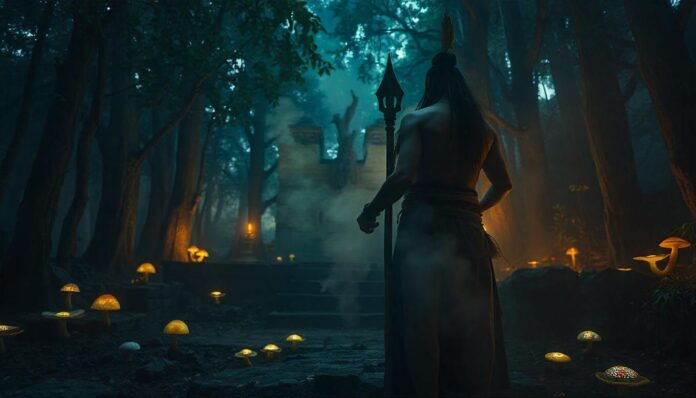Throughout history, numerous ancient civilizations have utilized psychedelic substances for various purposes. These powerful hallucinogens hold remarkable potential in modern medicine, particularly for psychiatric disorders. Delving into the historical use and cultural significance of these substances offers valuable insights for today’s burgeoning interest in psychedelics.
The timeless connection between psychedelics and ancient cultures
A discovery made in the Andes Mountains provides a fascinating glimpse into the use of psychedelics by the Tiwanaku civilization. Inside a shaman’s cave dating back over 1,000 years, archaeologists found drug paraphernalia with traces of substances such as psilocin and ayahuasca. This find highlights how deeply integrated these substances were within ancient rituals and daily life.
Historical records reveal that many indigenous communities across the Global South have long used what they refer to as “spirit medicines.” Unlike the modern Western view that sees psychedelics primarily as treatments for mental health issues, these cultures incorporated them into rituals, palliative care, and community-building activities.
Ritualistic and practical uses
In ancient societies, these substances weren’t limited to ceremonial use. They played a broad role in the social fabric, including aiding in creativity, facilitating deeper consciousness exploration, and even everyday problem-solving. For example, if something valuable was lost, the community would seek guidance from a medical practitioner.
Beyond ritualistic roles, spirit medicines often served in sacred rites and seasonal celebrations, utilized by cultures like the ancient Greeks and Romans, who ingested substances containing LSD-like hallucinogens. This historical context underscores the versatility and enduring significance of psychedelics.
Evidential roots of psychedelic practices
The lineage of psychedelic use extends far back in human history. Archaeological evidence indicates that the Peyote cactus, containing mescaline, has been used for religious and medicinal purposes since around 14,000 BC in Mexico and 8,600 BC in Peru. Similarly, mushrooms with psychoactive properties have an ancient tradition, especially noted among the Ojibwa community in the Great Lakes region.
There are documented instances of sacred mushroom depiction in Mesoamerican cultures through pictographic writings and carved stone artifacts. A notable reference is found in the Codex Vindobonensis Mexicanus 1, a Mixtec manuscript detailing the role of sacred mushrooms in their rituals. Such documentation illuminates the deep-seated reverence and sophisticated understanding of these substances.
Integration into daily life
Indigenous traditions show that psychedelics were not only about escapism or spiritual quests but were intricately woven into the social and cultural practices of the time. Communities across the Americas used these plants to foster connections, enhance communal bonds, and even address existential questions.
Researcher Osiris Sinuhé González Romero articulates how the narrative around these substances needs reclaiming. By recognizing the rich, multifaceted usage of psychedelics historically, there’s potential to better inform contemporary approaches to these compounds.
The renaissance of psychedelics in modern medicine
In recent years, there’s been a resurgence in the interest surrounding psychedelics as promising aids in treating mental health conditions such as depression, anxiety, and PTSD. Western medicine is rediscovering substances like MDMA, LSD, psilocybin, and ketamine. Despite this renewed interest, obtaining official approval for therapeutic use involves rigorous research and regulatory scrutiny.
For instance, the US FDA recently highlighted ongoing evaluations of MDMA as a treatment for PTSD. However, despite some encouraging results from early trials, more data is needed to ensure its efficacy and safety. As this field continues to evolve, it faces scientific and societal challenges.
Cultural perspectives and medical potential
Yuria Celidwen of the University of California notes that the term “psychedelic” itself is a modern Western construct. Indigenous wisdom shows a deeper, holistic relationship with these substances, framed more as spiritual companions than mere chemicals. Bridging these perspectives could enrich current medical paradigms.
By acknowledging the intricate histories and traditional uses of psychedelics, we can cultivate a more comprehensive and culturally sensitive approach to their application in modern therapy. It encourages a respect for the complex roles these substances have played throughout human existence.
Reviving ancient knowledge for contemporary healing
The journey of psychedelics from ancient shamanic practices to cutting-edge clinical research speaks volumes about their potent capabilities. Understanding past uses enables us to appreciate and potentially harness their full benefits today. This renaissance reflects a broader trend towards integrating traditional wisdom with modern science.
As the medical community continues to navigate the complexities of psychedelic therapies, the lessons gleaned from historical and cultural contexts will be invaluable. The integration of ancient knowledge may lead to innovative breakthroughs in mental health treatment, offering new hope where conventional methods fall short.
In sum, the legacy of psychedelics—from sacred rites in remote caves to highly regulated clinical trials—illustrates a captivating journey of rediscovery and modern application. Joining forces with the ancient world can inspire a richer, more holistic path forward in psychedelic research and therapy.


